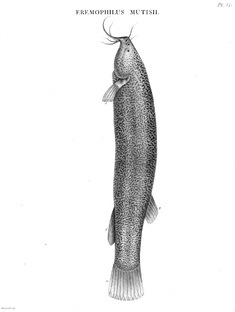Eremophilus
Eremophilus mutisii is a species of catfish (order Siluriformes) of the family Trichomycteridae, and the only member of its genus.[3] This fish grows to about 30 centimetres (12 in) and originates from the Bogotá River basin, which is a tributary of the Magdalena River. It has probably been introduced to Ubaté, Chiquinquirá, and Tundama valleys, Colombia.[4][5]
| Eremophilus | |
|---|---|
 | |
| Eremophilus mutisii, original illustration by Humboldt | |
| Scientific classification | |
| Kingdom: | Animalia |
| Phylum: | Chordata |
| Class: | Actinopterygii |
| Order: | Siluriformes |
| Family: | Trichomycteridae |
| Subfamily: | Trichomycterinae |
| Genus: | Eremophilus Humboldt, 1805 |
| Species: | E. mutisii |
| Binomial name | |
| Eremophilus mutisii Humboldt, 1805 | |
| Synonyms | |
|
Of Eremophilus | |
E. mutisii uses the vascularized central portion of its stomach for aerial respiration. Air ventilation takes place during a rapid dash to the surface with the expiration of old air preceding inspiration. Air-breathing occurs in hypoxic and normoxic water, but is not obligatory. The evolution of a reduced swimbladder is associated with a benthic mode of life in E. mutisii.[6][7]
This fish species is an excellent food fish. It is the only species of food fish which has been able to survive competition from introduced trout and carp species into the region.[4]
References
- World Conservation Monitoring Centre (1996). "Eremophilus mutisii". IUCN Red List of Threatened Species. 1996.CS1 maint: ref=harv (link)
- DoNascimiento, C.; Saúl Prada-Pedreros, S.; Guerrero-Kommritz, J. (2014). "Trichomycterus venulosus (Steindachner, 1915), a junior synonym of Eremophilus mutisii Humboldt, 1805 (Siluriformes: Trichomycteridae) and not an extinct species". Neotropical Ichthyology. 12 (4): 707–715. doi:10.1590/1982-0224-20130236.
- Ferraris, C.J.Jr. (2007). "Checklist of catfishes, recent and fossil (Osteichthyes: Siluriformes), and catalogue of siluriform primary types" (PDF). Zootaxa. 1418: 1–628.
- Froese, Rainer and Pauly, Daniel, eds. (2015). "Eremophilus mutisii" in FishBase. February 2015 version.
- Pinilla, G.; Abril, M.; González, E. (2006). "Growth, feeding and reproduction of the catfish Eremophilus mutisii". Revista de Biología Tropical. 54 (2): 589–597.
- Cala, P. (1987). "Aerial respiration in the catfish, Eremophilus mutisii (Trichomycteridae, Siluriformes), in the Rio Bogota Basin, Colombia". Journal of Fish Biology. 31 (3): 301–303. doi:10.1111/j.1095-8649.1987.tb05236.x.
- Cala, P.; del Castillo, B. & Garzon, B. (1990). "Air-breathing behaviour of the Colombian catfish Eremophilus mutisii (Trichomycteridae, Siluriformes)". Experimental Biology. 48 (6): 357–60.
